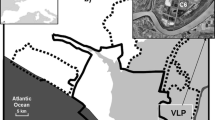Abstract
The photosynthesis of plankton sampled from the eutrophic Lake Loosdrecht was studied in Laboratory Scale Enclosures (LSEs) with regard to the rate of mixing. First, two LSEs were operated at different mixing rates. No significant differences in photosynthetic performance were found, with the exception of a depressed photosynthesis in the afternoon in the LSE which had a low mixing rate. Secondly, when mixing was stopped, the phytoplankton which stayed in the dark due to the steep light gradient in the LSE responded by changing its maximal photosynthetic capacity. The results show that the filamentous cyanobacteria in the lake can respond rapidly to changes in the depth of the mixed layer by altering their photosynthetic performance.
Similar content being viewed by others
References
Cullen, J. J. & M. R. Lewis, 1988. The kinetics of algal adaptation in the context of vertical mixing. J. Plankton Res. 10: 1039–1063.
De Kloet, W. A., 1982. The primary production of phytoplankton in Lake Vechten. In Gulati, R. D. & S. Parma (eds), Developments in Hydrobiology 11. Studies on Lake Vechten and Tjeukemeer, The Netherlands. Dr W. Junk Publishers, The Hague: 37–57.
Dubinsky, Z., P. G. Falkowski, A. F. Post & U. M. van Hes, 1987. A system for measuring phytoplankton photosynthesis in a defined light-field with an oxygen electrode. J. Plankton Res. 9: 607–612.
Eilers, P. H. C. & J. C. H. Peeters, 1988. A model for the relationship between light intensity and the rate of photosynthesis in phytoplankton. Ecol. Model. 42: 199–215.
Flik, B. J. G. & A. Keyzer, 1981. Estimation of primary production in the Lake Maarsseveen I with an incubator technique. Hydrobiol. Bull. 15: 41–50.
Gons, H. J., J. Kromkamp, M. Rijkeboer & O. Schofield, 1992. Characterization of the light field in laboratory scale enclosures of eutrophic lake water (Lake Loosdrecht, The Netherlands). Hydrobiologia 238: 99–109.
Harris, P. G., 1978. Photosynthesis, productivity and growth: the physiological ecology of phytoplankton. Arch. Hydrobiol. Beih. Ergeb. Limnol. 10: 1–171.
Jassby, A. D. & T. Platt, 1976. The relationship between photosynthesis and light for natural phytoplankton. J. Phycol. 12: 421–430.
Kirk, J. T. O., 1983. Light and photosynthesis in aquatic ecosystems. Cambridge University Press, Cambridge.
Neale, P. J. & J. Marra, 1985. Short-term variation of P max under natural irradiance conditions: a model and its implications. Mar. Ecol. Progr. Ser. 26: 113–124.
Osborne, B. A. & J. A. Raven, 1986. Light absorption by plants and its implications for photosynthesis. Biol. Rev. 61: 1–61.
Platt, T. & C. H. Gallegos, 1980. Modelling primary production. In P. G. Falkowski (ed.), Primary productivity in the sea. Plenum Press, N.Y.: 339–362.
Post, A. F., Z. Dubinsky, K. Wyman & P. G. Falkowski, 1984. Kinetics of light intensity adaptation in a marine planktonic diatom. Mar. Biol. 83: 231–238.
Post, A. F., Z. Dubinsky, K. Wyman & P. G. Falkowski, 1985. Physiological responses of a marine planktonic diatom to transitions in growth irradiance. Mar. Ecol. Progr. Ser. 25: 141–149.
Post, A. F., 1986. transient state characteristics of adaptation to changes in light conditions for the cyanobacterium Oscillatoria agardhii. I. Pigmentation and photosynthesis. Arch. Microbiol. 145: 353–357.
Reynolds, C. S., R. L. Oliver & A. E. Walsby, 1987. Cyanobacterial dominance: the role of buoyancy regulation in dynamic lake environments. N. Z. J. Mar. Freshwat. Res. 21: 379–390.
Richardson, K., J. Beardall & J. A. Raven, 1983. Adaptation of unicellular algae to irradiance: an analysis of strategies. New Phytol. 93: 157–191.
Rijkeboer, M., W. A. de Kloet & H. J. Gons, 1992. Interspecific variation in pigmentation: implications for production estimates for shallow eutrophic lakes using an incubator. Hydrobiologia 238: 197–202.
Rijkeboer, M., F. de Bles & H. J. Gons, 1990. Laboratory scale enclosures: concept, construction and operation. J. Plankton Res. 12: 231–244.
Van Liere, L., L. Breebaart & Y. L. Dullemont, 1989. Determining the relative number of prochlorophytes in lake phytoplankton using epifluorescence microscopy. Br. Phycol. J. 24: 391–394.
Van Liere, L. & A. E. Walsby, 1982. Interactions of cyanobacteria with light. In N. G.Carr & B. A. Whitton (eds), The biology of the cyanobacteria. Blackwell Scientific Publications, Oxford.
Author information
Authors and Affiliations
Additional information
This is publication 567 of the Centre for Estuarine and Coastal Ecology.
Rights and permissions
About this article
Cite this article
Kromkamp, J., Schanz, F., Rijkeboer, M. et al. Influence of the mixing regime on algal photosynthetic performance in laboratory scale enclosures. Hydrobiologia 238, 111–118 (1992). https://doi.org/10.1007/BF00048779
Issue Date:
DOI: https://doi.org/10.1007/BF00048779




